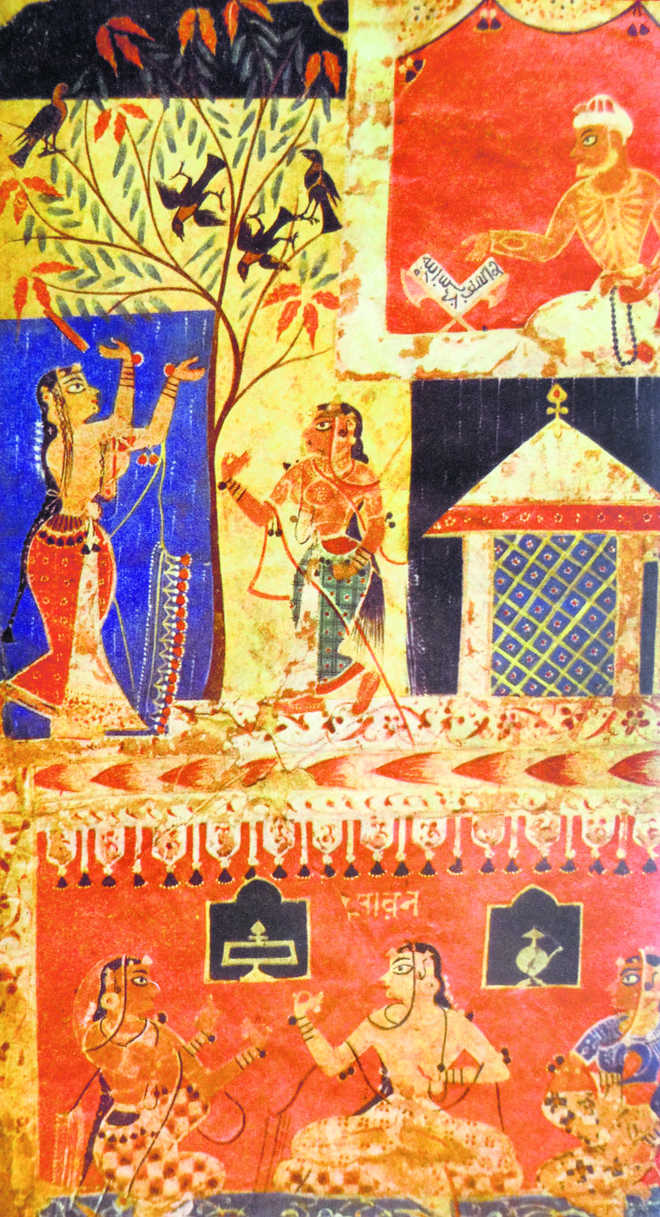
.
Neelam Mansingh Chowdhry
Certain books come with their own expectations and they never disappoint, especially the ones that flow from the magical pen of Dr B N Goswamy. Layer upon layer of beaten beauty surround the reader, providing a feast for the senses. I simply love the ease with which one chapter in the book, co-edited by Goswamy and Vrinda Agarwal, flows into the other, without conceit or subterfuge.
Tracing the history of Indian art through the ages, the two authors create breathtaking threads, structures and scenes, which, in their vividness and vivacity, are like tantalising whispers. Artists from Turkey and China compete gently, but resolutely, with the others before the reader is transported to the sheer joy and ecstasy of the eight rasas. Effortlessly, the scene then moves onto providing instruction on how assorted colours are prepared from leaves, flowers and stones, and then onto correct and exact painting techniques.
Let me at this stage pause and inquire: is this a book on poetry and art, or simply about facts and figures in the world of poetry and art? Or is it all interchangeable?
In short, the book is a delightful amalgam of both, laced with a sense of immediacy, despite dealing with the hoary history of Indian art. Its reflective introduction, subtly suggesting ways to approach the contents readily transports the reader into the secret and magical world of gods and goddesses. It gently explores a mélange of Sanskrit plays, peacocks and lingams with a somewhat bizarre, but charming ease and candour. It is perhaps the first compendium of its kind that could be labelled a ‘handbook’ for any scholar or lover of Indian art history.
At times, the book presents itself like an esoteric recipe book, as we encounter concepts like ‘pounding’ crushing’ and ‘pasting’ involving procedures that include leaves, flowers and lime; the quotidian activity of plastering a wall, for instance, is presented sensually as we meander through the pages. Furthermore, from References to the physical attributes of deities in the Rig Veda to The Eight Rasa the authors take the reader on a fascinating journey with a lightness that belies the wealth of information it imparts. The delicate, albeit effortless balancing between the classical, the sacred, the profane, the high and the low, is achieved with precise deftness. It is, indeed, a complex book with doses of disquieting, self-questioning challenges that invite introspection.
The task of putting together a book of this kind must have truly been arduous, as most of the information it includes was not only scanty but scattered. But to render this material cohesive and weave from it varied and disparate threads stretching from iconography to patronage, must have been a herculean intellectual feat. No biographies of the artists featured in the book existed and whatever little detail did was fragmented to the point of near obscurity.
As explanation of how the authors managed to string together a cohesive narrative, despite the hurdles, Goswamy disarmingly states in his introduction that the hard information the authors had from the past as far the arts were concerned came in the “form of whispers” that one could “sometimes barely hear”. The fact that these whispers became coherent voices centuries later is a tribute to Goswamy’s and Agarwal’s patient and diligent scholarship.
There is also no doubt that the book had the potential of becoming stodgy, despite the mine of information it presents. But the authors’ erudition makes it poetic and evocative, its esoteric contents retrieved and reclaimed from the obscurity of time. Its formatting, too, is an act of courage that melds together theoretical concepts with the conversations of sages who speak precisely of the juxtaposition between the arts and its technical and mathematical aspects of time and space. The resultant iconographical rules and artistic experiences are presented in a manner that transports the reader into a secret cabinet with infinite recesses, experiencing each one with wonderment and curiosity.
One realises only after completing the book that even though it is on art, there are no accompanying illustrations or visual information of any kind supporting the text. Surprisingly, this seeming lapse is not at all missed, as wealth of detail, history and information and the visual imagery it conjures up, makes the reader a willing participant in the unfolding of the rich and textured stories of the past.
The irony is that one of our greatest living art historians began his career in the Indian Administrative Services. To reject a life of comfort and certainty and exchange it for the unknown by treading an unexplored path with no road map would, without doubt, count as one of the most fortuitous detours in the history of art.



























